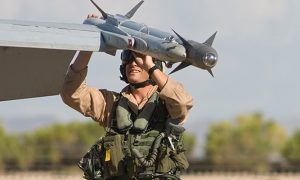
The US State department has approved the sale of the Raytheon AIM-9X infra-red air-to-air missile to Australia.
The request submitted by the US Defense Security Cooperation Agency (DSCA) and valued at $US534m (A$568m) is for “up to” 350 AIM-9X missiles, and also includes training and captive missiles, tactical guidance units, test sets and support equipment, spare and repair parts, publications and technical documents, personnel training and training equipment, and US government support and admin.
The Block II builds on the AIM-9X’s within visual range (WVR) high-off-bore-sight (HOBS) lethality and adds new software and a datalink so that it can steered by the launch aircraft towards a target that its own seeker cannot initially see. Called lock-on after launch, the improved seeker has a re-acquisition capability which makes the missile harder to evade, and will allow the Block II to be loft-launched at altitude before it sees its target, allowing it to fly much further.
The RAAF operates the AIM-9X on its F/A-18F Super Hornet fleet, and to date has only fielded the Block I version of the AIM-9X, while the RAAF’s classic Hornets operate with the MBDA AIM-132 ASRAAM missile. The Block IIs are being acquired under Project AIR 5349 Phase 2 which is the weapons phase of the ADF’s Super Hornet program.















Raymond
says:What happens to all the obsolescent, superseded missiles once replacements are in service? They don’t all get ‘fired off’ in weapons practice do they? Do they get placed into storage or just deactivated and dismantled?
australianaviation.com.au
says:They time-expire as the solid fuel in them goes off. Bigger missiles like the Harpoon use jet fuel and are stored without fuel, so they can have an indefinite shelf life if stored correctly. But many of the older and smaller solid fuelled missiles all have a life of maybe 10-15 years.
Just before they’re due to time expire, some are shot off in a ‘yippee’ shoot against drones or electronically generated targets which gives the fighter pilots some trigger practice. I have heard that they’re looking at storing solid fuel in replaceable canisters in missile airframes, but don’t know if that’s progressed
Cheers
Andrew
Darren
says:Now that ‘yippee’ airshow would be worth seeing.
Mark
says:I once witnessed an RN Harrier conduct a nightime fire of a Side Winder at a Lepus Flare. Got to be witnessed to believe. Lets not waste good money and have a decent fire work show.
Stephen
says:I thought this kind of upgrade was more software than hardware. Even if not, are we getting entire missiles or just the new parts and instructions, or both?